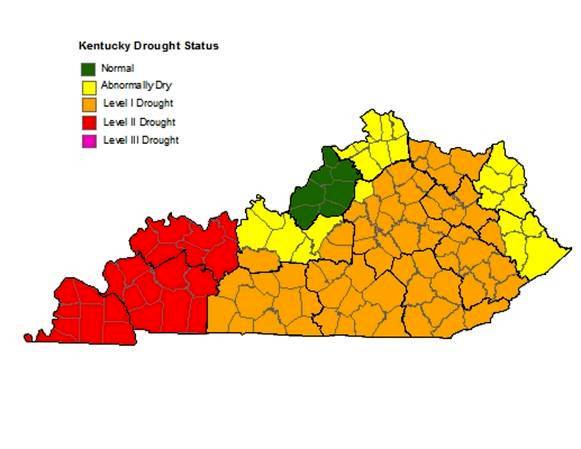 June 28, 2012 - 24 western Kentucky counties reach Level 2 drought status. Frankfort, Ky. (June 28, 2012) – The Office of the State Climatologist and the Kentucky Energy and Environment Cabinet, in coordination with the Kentucky Drought Mitigation Team, are issuing a Level 2 drought declaration for 24 counties in three Drought Management Areas (DMAs) in western Kentucky. In addition, a Level 1 drought has been declared for 66 counties in nine DMAs.
A Level 2 drought indicates severe drought conditions have developed. Counties with this designation can expect severe impacts to water-sensitive enterprises; depletion of water supplies in shallow wells, springs and ponds; increased incidences of wildfires; higher demands placed on water treatment facilities; and the imposition of water conservation advisories.
A Level 1 drought indicates moderate to severe drought conditions have developed primarily affecting soil moisture and vegetation. Counties with this designation can expect reduced supplies of agricultural water and heightened risk of wildfires.
Counties included in the Level 2 drought declaration:
Purchase DMA: Ballard, Calloway, Carlisle, Fulton, Graves, Hickman, McCracken, Marshall
Pennyrile DMA: Caldwell, Christian, Crittenden, Hopkins, Livingston, Lyon, Muhlenberg, Todd, Trigg
Green River DMA: Daviess, Hancock, Henderson, McLean, Ohio, Union, Webster
Counties included in the Level 1 drought declaration:
Barren River DMA: Allen, Barren, Butler, Edmonson, Hart, Logan, Metcalfe, Monroe, Simpson, Warren
Big Sandy DMA: Magoffin
Bluegrass DMA: Anderson, Bourbon, Boyle, Clark, Estill, Fayette, Garrard, Harrison, Jessamine, Lincoln, Madison, Mercer, Nicholas, Powell, Scott, Woodford
Buffalo Trace DMA: Bracken, Fleming, Lewis, Mason, Robertson
Cumberland Valley DMA: Bell, Clay, Harlan, Jackson, Knox, Laurel, Rockcastle, Whitley
Gateway DMA: Bath, Menifee, Montgomery, Morgan, Rowan
Kentucky River DMA: Breathitt, Knott, Lee, Leslie, Letcher, Owsley, Perry, Wolfe
Lake Cumberland DMA: Adair, Casey, Clinton, Cumberland, Green, McCreary, Pulaski, Russell, Taylor, Wayne
Lincoln Trail DMA: Grayson, Marion, Washington
Counties considered abnormally dry but not yet included in the Level 1 drought declaration:
Big Sandy DMA: Floyd, Johnson, Martin, Pike
Bluegrass DMA: Franklin
FIVCO DMA: Boyd, Carter, Elliot, Greenup, Lawrence
Lincoln Trail DMA: Breckinridge, Hardin, LaRue, Meade, Nelson
Northern Kentucky DMA: Boone, Campbell, Carroll, Gallatin, Grant, Kenton, Owen, Pendleton
Agriculture throughout the Commonwealth has been severely impacted by the lack of rainfall and above-normal temperatures, according to an official with the U.S. Department of Agriculture (USDA).
“Many farmers are reporting having to feed cattle because pastures are depleted,” said Bob Finch, emergency preparedness coordinator at the USDA Kentucky State Farm Service Agency. “This will be a major financial drain if pastures do not improve this fall. Farmers in central Kentucky who normally planted double-crop soybeans cannot because the ground is so hard. Farmers in western Kentucky are looking at record-low yields and in some cases a total failure.”
Wildfires are rapidly becoming a major concern as fields and forests continue to dry out, aided by the high temperatures and low humidity.
“Summer is usually a time of few wildfires in Kentucky,” said Leah MacSwords, director of the Kentucky Division of Forestry. “We need people to be extra careful with their outdoor activities so they don’t cause an unintended wildfire.”
Hydrologic problems continue to develop in the drought areas. Many streams and rivers are currently experiencing low-flow conditions. Kentucky Lake, Lake Barkley, Rough River Lake, Barren River Lake and Nolin Lake are all currently below normal pool. While these low lake levels are not likely to impact drinking water supplies obtained directly from the lakes, minimal dam releases during the summer could affect downstream water supplies as well as recreational activities on the lakes. Many small ponds and lakes are well below normal levels or are completely dry.
There are currently no water systems experiencing any water supply shortages. However, persistent drought can impact raw water availability or trigger unseasonably high water demands on a water system. All Kentuckians are encouraged to heed any requests for conservation from their local water supplier.
The National Weather Service’s Climate Prediction Center is currently forecasting above-normal temperatures and below-normal precipitation in the 6-to-10-day and 8-to-14-day outlooks for the entire state. Any rain that falls this weekend is expected to be isolated and will not provide significant drought relief. |







